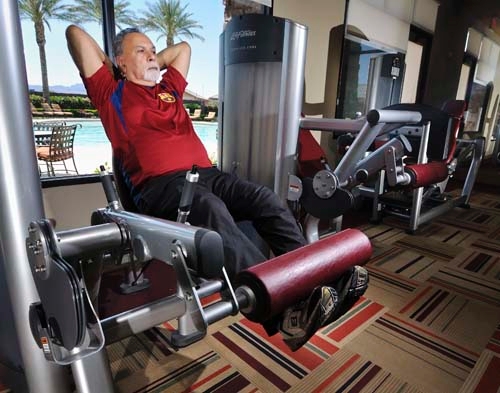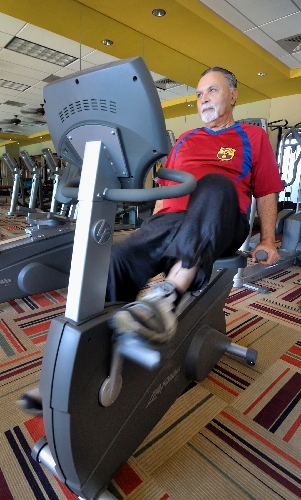Older Americans opt for surgery to keep active



Kohli Singh always has been an active guy.
“I used to be a very good cricketeer,” says Singh, who even now, at age 71, works out four or five days a week.
A few years ago, Singh began to feel pain – not terrible pain, but noticeable and annoying pain- in his knees.
“When I’m sitting down, there is no pain. Only when I start walking and when I get up,” he explains. “I can walk about a half-mile, but I can’t run. But I limp a little bit.”
He’s tried all of the usual stopgap measures for easing his knee pain, but none has worked well. So he’s now considering the next potential treatment: knee replacement surgery.
Singh acknowledges that he’s not thrilled about the prospect.
“I’ve never been in a hospital and I’ve never had surgery,” he says. “So you can imagine how difficult this is for me.”
Still, Singh figures that if knee replacement surgery will allow him to remain active, it’s worth considering. And if Singh were to ask Ed Thiessen for his advice?
“When you get to the point where you’re sore all the time, do it. Don’t put it off,” says Thiessen, 71, an avid bicyclist who had knee replacement surgery four years ago and now wishes he’d done it long before that.
Singh and Thiessen aren’t alone in coping with age- and use-related joint problems. Increasing numbers of older – and getting-older – Americans are opting for orthopedic procedures that they hope will allow them to remain active well into their golden years.
Consider, for instance, a study released in November by the U.S. Agency for Healthcare Research and Quality that notes that women and men ages 45 to 64 were 2½ times more likely to be hospitalized for knee replacement surgery in 2009 than in 1997.
Note, too, says Henderson orthopedic surgeon and sports medicine physician Dr. Michael Crovetti Jr., that the “fastest-growing” age group for hip and knee replacements today is made up of people ages 45 to 65 and that “in 2011, for the first time, more than 50 percent of patients in the U.S. (needing) hip replacements were under the age of 65.”
That is in part because Americans are living longer, which increases the chances that a hip or knee replacement may be in the typical American’s future.
“The average female today lives to 86 and the average male lives to 82,” Crovetti says. “So we know, when looking at people in their 50s and up, with hip or knee replacements, we’ve got to get them through until their 80s.”
Fortunately, technological improvements have led to the creation of hip and knee replacements that can last longer than those of a decade or two ago. That reduces the chances that someone who receives an implant at age 60 or 70 or 80 will have to undergo a second replacement in his or her 70s, 80s or 90s.
“It used to be a hip or a knee placement was a 10- to 12-year solution,” Crovetti says. “Now we have hips and knees that may last 20 or 25 years.”
Mindy Renfro, a physical therapy professor and geriatric specialist at Touro University Nevada College of Osteopathic Medicine, notes that “we used to tell people to wait until their 70s (to have a knee replacement) because the projected survival of a new knee was only 15 years.
“Now that we know the knees are better and lasting longer and staying in better, younger people are being encouraged to have it because it’s easier to rehab from it.”
All of this has, in turn, helped to make knee or hip replacement an option suitable for consideration for a wider age range of patients experiencing joint pain.
“I do think physician’s perceptions have changed,” says Dr. Carol Scott, sports medicine director at the University of Nevada School of Medicine. “I am much more willing to talk to patients about these kinds of options if they have a lot of pain.”
Improvements in techniques and procedures also have made joint replacement surgery more physically agreeable – less painful, with shorter recovery and rehab times – than a decade or two ago, Crovetti says.
Crovetti says he performs hip and knee replacements in a surgical center, rather than in a hospital, and patients undergo rehabilitation in a facility “where they get an accelerated protocol for two days.”
Where a hip or knee replacement used to be “an hour-and-a-half to two-hour procedure, our average operating time today is 42 minutes,” Crovetti says, and patients who used to be hospitalized for five to seven days now are hospitalized for two.
But even more than demographic changes or technological advances, older boomers and seniors may opt for joint replacement surgery for a more personal reason: They will do whatever it takes to remain active.
Crovetti says a significant segment of his patients are older people who “take great care of themselves and have a blast in life and just don’t want to slow down.”
It used to be that someone was forced into considering hip or knee replacements because “they just couldn’t take the pain, they couldn’t take another step, they couldn’t walk to the refrigerator, they couldn’t go to work,” he says. “Today, it’s they can’t hike, they can’t play golf, they can’t go bowling, they can’t go skiing or snowboarding. It’s a different level of ‘can’ts.’ It’s a quality of life issue.”
Scott agrees. “I do think, overall, that people are a little more interested in their health and staying active, because we push that so much – that exercise is a great thing for all those chronic diseases that are out there,” she says.
Helping to prevent or reverse medical problems associated with inactivity – including diabetes and obesity – by allowing people to remain active is considered one good argument in favor of having hip or knee replacement. Singh is a retired nursing home administrator and has observed firsthand the physical and mental consequences of inactivity – including depression stemming from a lack of mobility.
While Singh says he probably won’t make a decision about knee replacement surgery for six months or so – by then, he expects to have finished work on a master’s degree in social work – he has begun researching the issue.
“Certainly, this question is a personal choice I have to make myself,” he says.
Thiessen, who retired three years ago from the state of Nevada, began bicycling during the early ’80s, riding the 29-mile round-trip to work.
Then, he says, “the knee started wearing out. I had trouble walking across the street, but I could ride forever because it’s not weight-bearing.”
So, at age 66, he decided to get a replacement.
“It wasn’t a hard decision,” he says. “I was 100 percent for it. I was psyched up for it. I just wanted to get rid of the pain in the knee.”
Recovery went well, he says. While there was some pain for the first month or so, Thiessen was on a trainer about eight days after surgery, and “it really took a couple of days before I could make a full pedal stroke.”
Now, Thiessen says, “I don’t pay attention to it.”
Thiessen recommends that anyone who needs the surgery just do it. “It feels so good now that, if you wait a year, you haven’t gained anything.”
However, prospective patients also should understand that rehab is work, and that you have to go into it with a positive attitude.
“But everyone I know that’s done it, they say, ‘Why didn’t I do this sooner?’ ” Thiessen says. “Every one of them.”
Nor is a joint replacement a quick fix. Scott says complications may include blood clots and problems with implants. And, she says, patients also should have realistic expectations for post-surgical activities.
“If you’re a big-time runner or jogger, you maybe decide, ‘I’m going to be a hiker or a biker,’ ” she says. “You probably do want to decrease the impact of the activity after the surgery.”
Contact reporter John Przybys at jprzybys@review
journal.com or 702-383-0280.












